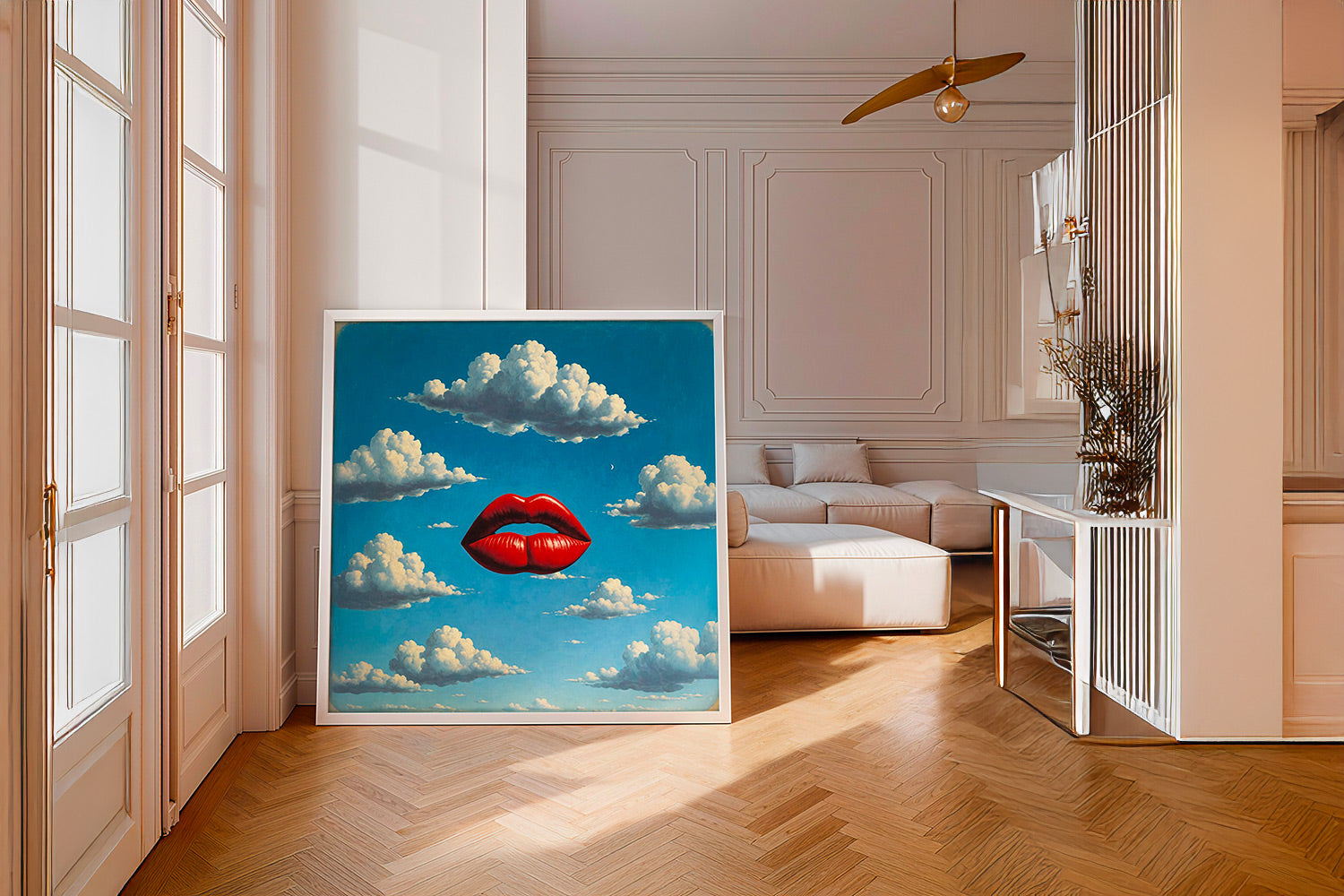Louis Janmot: The Imaginative Painter Who Brought Dreams to Life

Louis Janmot: self-portrait (1832)
Some painters depict the world as it appears, others express what stirs within their hearts. Then there is Louis Janmot, who captured the whispers of his soul during long, contemplative nights. This 19th-century French artist produced works that hover delicately between reality and dream, prompting viewers to ponder where the tangible ends and the spiritual begins.
Born in Lyon in 1814, Janmot became one of France’s most enigmatic creatives. His paintings do more than adorn walls — they seem to breathe with an enigmatic vitality. While many of his peers concentrated on landscapes or portraits, Janmot charted a different course, illustrating emotions, reflections, and the unseen bonds linking human souls.

Louis Janmot: Le Poème de l’âme (1835–1881)
The Poem of the Soul: Where Art Meets Verse
Janmot’s magnum opus, Le Poème de l’âme (The Poem of the Soul), stands as one of the most ambitious undertakings in art history. This series of 18 canvases narrates the journey of a soul through life, death and beyond. Each painting unveils a fresh chapter in this cosmic tale.
The narrative begins with the innocence of childhood and follows two souls — a man and a woman — as they navigate earthly existence, confront moral trials, and ultimately transcend corporeal confines. Imagine a 19th-century graphic novel, painted with the finesse of a master and the insight of a mystic.
What sets these works apart is not merely their technical prowess. Janmot gave form to intangible ideas such as love, faith and redemption. His figures appear to glow from within, set against ethereal landscapes that hint rather than specify locales. He devoted over twenty years to this series, infusing it with his philosophical convictions and spiritual experiences.
A Style That Broke the Mould
While many artists of his day embraced realism or impressionism, Janmot forged his own visual dialect. His approach blends classical technique with romantic sentiment and symbolist motifs. The outcome? Paintings that feel both timeless and otherworldly.
His palette favours gentle blues, warm golds and earthy hues. These choices were deliberate: Janmot believed certain colours evoked particular spiritual states. Blue symbolised divine love, gold represented enlightenment, and earth tones anchored his celestial visions in human reality.
The figures often seem suspended between worlds, their expressions reflecting profound contemplation or mystical insight. Unlike the sharply defined forms popular in his era, Janmot’s subjects possess softer outlines, as if emerging from the morning mist.
Faith and Genius Intertwined
To truly grasp Janmot’s work, one must understand his faith. He was not merely a Catholic artist painting religious scenes; his entire artistic philosophy was rooted in spirituality. He regarded art as a form of prayer, a means to convey divine truths to earthly audiences.
This outlook rendered him somewhat of an outsider in artistic circles. While Parisian critics debated technique and style, Janmot was chiefly concerned with the soul-stirring power of his imagery. He believed art should uplift viewers, helping them connect with higher spiritual realms.
His religious paintings eschew dramatic martyrdom scenes common in Catholic art, favouring instead quiet moments of revelation, gentle angelic guidance, and serene transitions between life and death. Even those without religious beliefs often find themselves moved by the calm and hopefulness in his work.

Louis Janmot: Le Poème de l’âme – 18 paintings (montage)
Beyond The Poem of the Soul
Although Le Poème de l’âme dominates discussions of Janmot’s oeuvre, he produced numerous other notable works. His portraits share the same mystical aura as his allegorical pieces. Subjects appear caught in moments of introspection, their eyes hinting at profound depths of thought and feeling.
Janmot also painted landscapes, though these were far from conventional rural scenes. His natural settings serve as stages for spiritual drama. Trees symbolise growth and endurance, rivers evoke the passage of time, and mountains suggest the eternal and immutable nature of divine love.
One particularly striking painting, The Flight into Egypt, portrays the Holy Family’s journey as a dreamlike procession through a landscape that feels more imagined than observed. This work exemplifies Janmot’s talent for transforming familiar biblical stories into deeply personal reflections.
A Legacy Rooted in Lyon
Janmot remained closely tied to his native Lyon throughout his career. The city’s spiritual and intellectual climate profoundly influenced his development as an artist-philosopher. Lyon’s rich Catholic traditions provided fertile ground for his mystical leanings, while its status as a hub of textile manufacture exposed him to decorative arts and pattern design.
Today, Lyon’s Musée des Beaux-Arts houses the complete Poem of the Soul series. Visitors often spend hours moving from one painting to the next, following the narrative thread that unites these visual chapters. The museum setting allows the series to be experienced as Janmot intended — a continuous journey rather than isolated works.
Encountering Janmot’s Art Today
Contemporary audiences discovering Janmot often feel an immediate affinity with his vision. In our fast-paced, digital age, his contemplative paintings offer a welcome pause. They invite slow, mindful viewing — a form of engagement increasingly rare in modern culture.
Art collectors and interior designers alike are growing to appreciate Janmot’s distinctive aesthetic. His paintings are especially suited to spaces designed for reflection: studies, bedrooms or meditation rooms. The gentle colours and spiritual themes foster atmospheres of calm and introspection.
For those wishing to explore Janmot’s work, high-quality reproductions make his art accessible to homes across the UK. Posterscape offers a carefully curated selection of prints featuring Janmot’s most significant pieces, allowing art enthusiasts to enjoy his vision without needing to visit European galleries.
Technique and Materials Used by Janmot
Janmot primarily employed oil paints, layering transparent glazes to achieve his signature luminous effect. This technique, inspired by Renaissance masters, enabled him to create the glowing, ethereal quality that defines his style.
He frequently began with detailed sketches, meticulously planning compositions before applying paint. This methodical approach suited his philosophical themes — every element in his paintings carries symbolic weight. Nothing in a Janmot work is accidental.
The artist also worked in other media, including lithography and pastel. These smaller-scale works reveal his skill in capturing subtle emotional nuances. His lithographs of The Poem of the Soul helped disseminate awareness of the series beyond Lyon’s borders.
Janmot’s Influence on Subsequent Artists
Though Janmot never founded an artistic movement, his influence can be traced through generations of symbolist and spiritually inclined artists. His fusion of literary and visual elements inspired painters seeking to transcend mere representation and explore deeper meanings.
Symbolist painters such as Gustave Moreau and Odilon Redon shared Janmot’s fascination with depicting the unseen realms of dreams, myths and spiritual experience. While their styles varied, they inherited his belief that art should speak to the soul as well as the eye.
Contemporary artists continue to draw inspiration from Janmot’s approach. His readiness to paint abstract ideas like love, faith and redemption resonates with modern creatives exploring spiritual themes within secular contexts.
Why Janmot’s Work Remains Relevant
In an age of rapid technological advancement and growing materialism, Janmot’s spiritual focus offers something many yearn for: a connection to transcendent values. His paintings remind us that human existence encompasses more than what can be measured or quantified.
His blending of poetry and painting also anticipates today’s interest in multimedia and interdisciplinary art. Long before such combinations were commonplace, Janmot demonstrated how visual and literary arts could enrich one another.
His example encourages viewers to slow down, reflect and consider profound questions about life’s meaning and purpose. In a world dominated by fleeting images and instant communication, Janmot’s contemplative works provide a rare and valuable visual experience.

Musée d’Orsay – Louis Janmot exhibition – photo by Thibaut Voisin
Recent Acclaim at the Musée d’Orsay
Janmot’s significance received major international recognition when Paris’s Musée d’Orsay hosted a comprehensive exhibition devoted to The Poem of the Soul. This exceptional show reunited both cycles of the series for the first time in decades, allowing visitors to experience the full narrative journey Janmot envisioned. The museum’s presentation was notably innovative, combining visual and textual elements by enabling visitors to listen to Janmot’s 2,814-verse poem while viewing the paintings.
This approach honoured the artist’s original concept of his work as a hybrid literary and pictorial creation. The exhibition situated Janmot within the wider context of 19th-century art movements, drawing parallels with William Blake, the Pre-Raphaelites, and later symbolists such as Odilon Redon. The collaboration between the Musée d’Orsay and Lyon’s Musée des Beaux-Arts made this extraordinary experience possible, bringing Janmot’s mystical vision to a broader international audience and securing his place in art history.
Collecting and Displaying Janmot’s Art
Original Janmot paintings seldom appear on the art market, making high-quality reproductions the primary way most people encounter his work. When selecting prints, seek out those that faithfully capture his subtle colour harmonies and luminous effects.
His paintings are best displayed in environments that complement their contemplative nature. Avoid placing them in busy areas or alongside works with competing visual narratives. Janmot’s art rewards quiet, focused appreciation rather than casual glances.
Consider lighting carefully when exhibiting Janmot reproductions. His paintings seem to emit an inner light, an effect enhanced by gentle illumination. Steer clear of harsh spotlights that might flatten the delicate tonal gradations he painstakingly achieved.
For further information on Louis Janmot’s life and work, the Wikipedia article offers a thorough overview of his career and artistic evolution. Museum websites also provide valuable insights for those wishing to delve deeper into this extraordinary artist’s vision.
Louis Janmot created art that transcends its era, speaking directly to universal human experiences of love, loss, hope and transcendence. His paintings continue to offer glimpses of beauty and meaning that remain as resonant today as they were in 19th-century Lyon.


Leave a comment
This site is protected by hCaptcha and the hCaptcha Privacy Policy and Terms of Service apply.